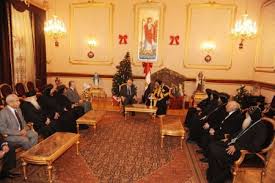 The agony of sectarian violence and discrimination, the fear of and anger at the world outside the walls of the Patriarch-dominated Church, the search of long overlooked rights and the striving for citizenship, all combined is a story that many of Egypt's Copts — considered a minority — are living with.
The agony of sectarian violence and discrimination, the fear of and anger at the world outside the walls of the Patriarch-dominated Church, the search of long overlooked rights and the striving for citizenship, all combined is a story that many of Egypt's Copts — considered a minority — are living with.
Almost on the eve of the vote on a draft constitution promoted as a text to establish rights of citizenship, Mariz Tadros issued through the American University in Cairo Press her in-depth reading of the state of affairs for the Copts of Egypt.
Copts at the Crossroads: The Challenges of Building an Inclusive Democracy in Egypt offers a detailed account of the story of Copts across the last 10 years of rule of ousted president Hosni Mubarak, where sectarian violence against the Christian minority was on a constant high, their participation in the January 25 Revolution, where they made a choice to overlook their own agony in favour of a wider national call for "Bread, freedom and justice," and the dismay they lived as the euphoria of Tahrir dissipated and tensions reopened between some Muslims and Coptic Christians in general.
Far from falling into the easy trap of reducing the history of anti-Coptic discrimination to a peak during the Islamists' year in office, Tadros takes a step back and looks at the accumulation of discrimination across the last decade of Mubarak rule that included, in addition to anti-Copt violence, a wide range of injustices that incrementally fed into the demonstrations of 25 January 2011.
Tadros provides evidence through articulate testimonies and detailed accounts, verified with dates and data, offering copious evidence of the abuse of Copts on the part of the state security apparatus that used the "Coptic file" to manipulate civil hostilities to serve the purpose of the state's political hegemony.
On the other hand, Tadros does not infer that Copts are persecuted as such, and in all circumstances. She looks into the corridors of power in the Church and reflects on the complexity of the relationship between the legendary and long-serving Patriarch of the Coptic Orthodox Church, Pope Shenouda, and the long ruling Mubarak, which culminated in an unspoken pact that granted Mubarak the clear support of the Church, which in turn allowed no room for Coptic dissent. When dissent broke out, Tadros reminds, it was the Pope and not the president who showed the greater wrath.
Eventually, as this pact failed to stop growing acts of violence against Christians, the protests of Copts started — first behind the walls of the Church that Copts had learned earlier to embrace (in keeping with the Egyptian proverb that those who walk next to the walls are always safe), through the dramatic encounter between Shenouda and Mubarak’s predecessor, Anwar Sadat, that had culminated in Sadat’s isolation of the Patriarch.
Later, as Copts started to demonstrate outside the Church walls, after protests inside the Church failed to stop the violence, they eventually found their way to speak up against both the Patriarch and the president. This was the beginning of their path to join Tahrir, not as Copts but simply as Egyptian citizens — even if that citizenry was often compromised.
Later, Tadros remarks, the Copts fell prey to another pact: the one between the Supreme Council of the Armed Forces (SCAF) that ruled the country after Mubarak stepped down on 11 February 2011, and the Muslim Brotherhood.
It was this pact, Tadros's book argues, that took things back to where they were before the revolution, where the political hegemony of the state (in this case being the vested interests of SCAF and the political ambitions of the Muslim Brotherhood) took precedence over the cause of citizenship.
“The Test of Qena” in April 2011, where the state bowed to the pressure of Islamists and decided to sack, because he was Copt, a Coptic governor who was assigned to Qena, was a fulcrum point.
From there on in, it has been a tough battle for Copts. Perhaps the lowest point was Maspero in October 2011, when Copts were killed during an anti-discrimination protest by law enforcement bodies with accusations made that they were mowed down just because they were Copts who were protesting the burning of their churches.
But the book of Tadros is not just about lamenting the state of affairs for Copts. It also aims to suggest options for ending sectarian violence and promoting an inclusive democracy.
The increased representation of Copts in parliament through the list system in elections is offered by Tadros as a step on the way to "integration." This integration, the book argues, will require wise concessions from leaders.
The book offers the integration of Ottoman minorities in post-Communist Romania as an example, while taking into consideration the specifics that have coloured the experience of the road to citizenship of Egypt's Copts.



